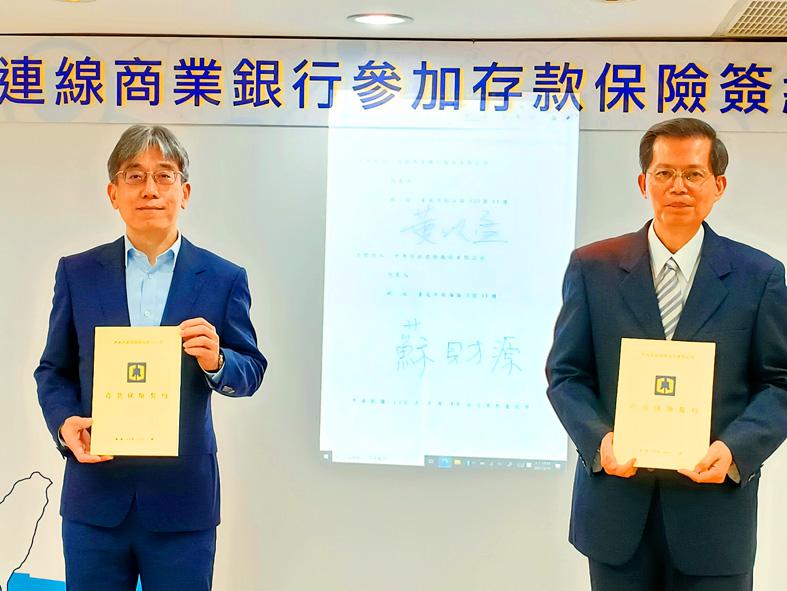Line Bank Taiwan Ltd (連線商業銀行), the second Internet-only bank in the nation, is to begin trial operations on Wednesday, before an official launch next month, Line Bank general manager Morris Huang (黃以孟) said on Friday.
The bank has completed several rounds of tests, such as stress tests, integration tests and user tests, and the bank is well-prepared to open to the public, Huang said.
The bank also signed an agreement with Central Deposit Insurance Corp (CDIC, 中央存保) to provide deposit insurance to its clients.

Photo: Lee Chin-hui, Taipei Times
Huang said that 700 employees of the three Taiwanese subsidiaries of Line Corp would be offered services in the trial.
As a Web-only bank, it has placed much emphasis on cybersecurity, Huang said.
The bank would initially offer debit card services and personal loans, but more preparations would be needed before credit card services could be offered, he said.
Once it offers services to the public, the bank would start with a promotion campaign, but it would not initially engage in price competition to achieve a certain market share, Huang said.
Line Financial Taiwan Corp (台灣連線金融科技), which owns 49.9 percent of Line Bank, last quarter started a similar Internet-only bank in Thailand — Line Bk — which has been faring as expected, Huang said.
The Thai bank’s performance would serve as a benchmark for the Taiwanese operations, he said.
Rakuten International Commercial Bank Co (樂天國際商銀), Taiwan’s first Web-only bank, opened in January, while Next Bank (將來銀行) is expected to become the third, as its application to begin operations is under review at the Financial Supervisory Commission.

GROWING OWINGS: While Luxembourg and China swapped the top three spots, the US continued to be the largest exposure for Taiwan for the 41st consecutive quarter The US remained the largest debtor nation to Taiwan’s banking sector for the 41st consecutive quarter at the end of September, after local banks’ exposure to the US market rose more than 2 percent from three months earlier, the central bank said. Exposure to the US increased to US$198.896 billion, up US$4.026 billion, or 2.07 percent, from US$194.87 billion in the previous quarter, data released by the central bank showed on Friday. Of the increase, about US$1.4 billion came from banks’ investments in securitized products and interbank loans in the US, while another US$2.6 billion stemmed from trust assets, including mutual funds,

Micron Memory Taiwan Co (台灣美光), a subsidiary of US memorychip maker Micron Technology Inc, has been granted a NT$4.7 billion (US$149.5 million) subsidy under the Ministry of Economic Affairs A+ Corporate Innovation and R&D Enhancement program, the ministry said yesterday. The US memorychip maker’s program aims to back the development of high-performance and high-bandwidth memory chips with a total budget of NT$11.75 billion, the ministry said. Aside from the government funding, Micron is to inject the remaining investment of NT$7.06 billion as the company applied to participate the government’s Global Innovation Partnership Program to deepen technology cooperation, a ministry official told the

Taiwan Semiconductor Manufacturing Co (TSMC, 台積電), the world’s leading advanced chipmaker, officially began volume production of its 2-nanometer chips in the fourth quarter of this year, according to a recent update on the company’s Web site. The low-key announcement confirms that TSMC, the go-to chipmaker for artificial intelligence (AI) hardware providers Nvidia Corp and iPhone maker Apple Inc, met its original roadmap for the next-generation technology. Production is currently centered at Fab 22 in Kaohsiung, utilizing the company’s first-generation nanosheet transistor technology. The new architecture achieves “full-node strides in performance and power consumption,” TSMC said. The company described the 2nm process as

Even as the US is embarked on a bitter rivalry with China over the deployment of artificial intelligence (AI), Chinese technology is quietly making inroads into the US market. Despite considerable geopolitical tensions, Chinese open-source AI models are winning over a growing number of programmers and companies in the US. These are different from the closed generative AI models that have become household names — ChatGPT-maker OpenAI or Google’s Gemini — whose inner workings are fiercely protected. In contrast, “open” models offered by many Chinese rivals, from Alibaba (阿里巴巴) to DeepSeek (深度求索), allow programmers to customize parts of the software to suit their